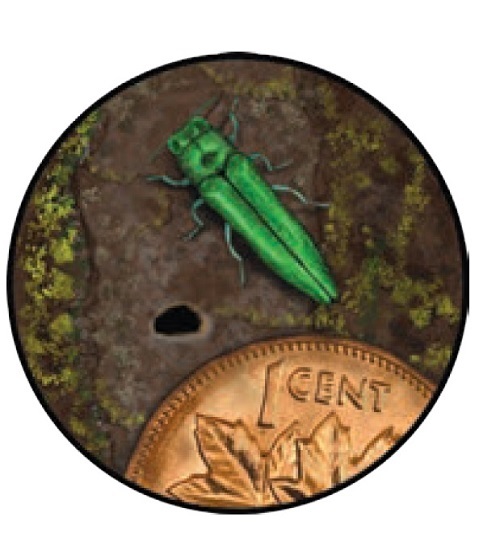| The Sandisfield Times |
|---|
| Good News for Our Ash Trees Fighting Back Against the EAB |
|
By Tom Christopher Published September 1, 2024. |

|
|
For anyone who loves Sandisfield's forests, the arrival of the Emerald Ash Borer (EAB) a dozen years ago was a tragedy. The Times published a scary article, "Kiss Your Ash Goodbye," in 2013. Now there may be good news for our surviving ash trees. How It Got Here In its original homeland, northeast Asia and Russia, this colorful beetle is a minor pest. Because the ash trees there evolved along with the EAB, they developed chemicals in their tissues that made them semi-immune, so that the beetle is only successful in attacking already weakened trees that are failing from other causes. As Dr. Claire Rutledge of the Connecticut Agricultural Experiment Station explained to me recently, the EAB actually performs a useful service in its native range, helping to recycle the wood of such dying trees and making room for new growth. When, however, the EAB hitchhiked to North America in the wooden packing materials of Asian goods sometime before 2002, it turned into something much more menacing. Our ash trees, which had never had contact with this pest before, had less defenses against it. And so the beetle could attack even healthy trees successfully. In addition, there were few predaceous insects in our woods who recognized the EAB as edible. These two factors led to population explosions whenever EAB beetles arrives in some area of eastern North America. The beetles breed unchecked, laying eggs in bark crevices of the ash trees that hatch in a couple of weeks into cream-colored, worm-like larvae that bore down into the sapwood of the tree, disrupting the flow of nutrients. Within a couple of years typically the boring larvae will girdle and kill the tree. What Happened Here The effect in Sandisfield has been to kill almost all the ash trees within our woods, which had constituted about 3 percent of all our trees. The loss of so many trees has been devastating, not only in terms of tree biodiversity but also because 98 species of our native insects depended entirely on ash trees for their survival, and an additional 300 or so native insect species also fed at least partially on them, including about 150 species of moth and butterfly caterpillars which were important foods for songbirds raising chicks. Besides the losses that result directly from the loss of the ash trees, their deaths also create an opportunity for further forest degradation. The loss of each ash tree opened a hole in the Sandisfield forest canopy, an opportunity for the growth of other plant species, and all too often these have been aggressive non-native invasive plants that do not support native wildlife. Fighting the EAB Fortunately, insect specialists such as Dr. Rutledge had learned from previous invasions of foreign pests and were able to take action quickly. Under the leadership of the U.S. Department of Agriculture, researchers were sent to the EAB's homeland to find predatory insects that fed more aggressively on it, and testing began in laboratories to make sure that these predators would not attack any North American insects as well. Four species of Asian wasps were identified in this way that parasitized emerald ash borers at various stages in their lives, and a program began to release them as a "biological control" into North American woods where the EAB had already appeared. These biological controls, according to Dr. Rutledge, have proven effective in reducing EAB populations to a low level. However, they were most effective in preventing ash tree deaths if they were introduced early, when EAB had just arrived in an area and before its population had exploded. Unfortunately, the beetles' arrival in a community often went undetected until they were already very numerous and the trees began to die. Dr. Rutledge and her colleagues found a reliable early detection system in the activities of a native wasp, the smokey winged beetle bandit. Female wasps of that species sting and paralyze wood-boring beetle that they bring back to their subterranean nests to save as food for their offspring. Dr. Rutledge and her colleagues have found that the beetle bandit is adept at locating any EAB beetles in the area. The wasp likes to excavate its nests in the soft, sandy soil of baseball infields. Dr. Rutledge enlisted a host of citizen scientists to watch baseball fields with beetle bandit colonies, equipping the volunteers with nets to catch and release the wasps as they bring their prey home. This has proven to be a very efficient EAB detection system. The combination of early detection and biological control offer hope for the future of our ash trees. Although all of our native ashes are vulnerable when attacked by large populations of EAB, some individual trees have proven resistant when exposed to smaller infestations. Indeed, according to Dr. Rutledge, some 40 percent of our native white ashes, the most common species in our woods, have shown such resistance and can survive the more limited attacks. Some individuals of the green ash, popular as a street tree, have also proven similarly resistant. This has led Dr. Rutledge to feel some optimism for the future of this genus of trees. "Kiss Your Ash Good-Bye" was the title of an article in the April 2013 issue of this paper. Thanks to the expertise of our forest scientists, this advice seems to have been premature.
If you have noticed dark stripes between the veins on the leaves of our local beech trees, you've detected the latest threat to our forests, beech leaf disease. Not much is known as yet about this disease, other than the fact that it is associated with infestation by a non-native nematode, a microscopic worm. First detected in northeastern Ohio in 2012, beech leaf disease appeared in southwestern Connecticut in 2019, and has spread to the forests of Massachusetts since then. Where this pest originated and how it spreads is still not clear. However, the effects are obvious. Leaves that emerge in the spring with the characteristic discoloration turn leathery, curl, and drop prematurely from the tree as effected branches die back to the trunk. Young trees are more susceptible and typically die within a few years of infection. Older trees tend to hang on a couple of years longer before they too die. A couple of pesticides have shown some effectiveness at controlling the nematode when applied as foliar sprays or injected into the tree trunks. This sort of treatment may provide protection for landscape specimens but can't stop the spread of the disease through our woods. American beech (Fagus grandifolia) is a mainstay of our woods, supporting numerous native insects and producing oily nuts in late summer that feed a wide range of wildlife, including squirrels, chipmunks, black bear, deer, foxes, ruffed grouse, ducks, and wild turkeys. Beech trees are also popular nesting habitat for songbirds such as wood thrushes, scarlet tanagers, and our state bird, the black-capped chickadee. |

|
©The Sandisfield Times. All rights reserved.
Published September 1, 2024